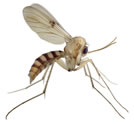10 April 2010
Dr. Art Borkent, biting midge expert, featured
09 October 2009
In the Year of Darwin, Darwin Core Standard Ratified!
The TDWG Executive Committee announces the official ratification of Darwin
Core (http://rs.tdwg.org/dwc/index.htm) as a TDWG standard.
Darwin Core joins four other TDWG standards- http://www.tdwg.org/standards/
that provide a reference for sharing information about biodiversity. Lead
author, John Wieczorek, and his co-authors, Markus Döring, Renato de
Giovanni, Tim Robertson, and Dave Vieglais have done an amazing job in
writing, organizing, and dealing with feedback during the review process. We
can only have a small insight into the effort that John and his team have
invested in Darwin Core.
We also appreciate the work that Gail Kampmeier has done as Review Manager
since her appointment in February 2009. There was an initial peer review
followed by two months of public review, punctuated by ongoing discussions
and periodic updating of the draft standard now being ratified by the TDWG
Executive Committee.
John, Markus, Renato, Tim, Dave and Gail deserve contributions of good
French wine in Montpellier! Thank you and congratulations to all who
contributed.
Donald Hobern, Chairman, TDWG.
24 September 2009
Naming Genes: What's in a Name?
21 September 2009
7th International Congress of Dipterology

The first announcement for the 7th International Congress of Dipterology (or IDC7 for short) was just released and the venue and program promise to be spectacular! The Congress Chairman, FLYTREE's own David Yeates, welcomes conferees to the first Diptera Congress in Latin America, from 8-13 August in San Jose, Costa Rica. Manuel Zumbado chairs the organizing committee for this event that will draw those interested in flies from across the globe.
13 July 2009
FLYTREE scientists identify the closest relatives of the flies!
17 June 2009
Supertrees & the Tree of Life
Lambkin C.L., Trueman J.W.H., Yeates D.K., Holston K.C., Webb D.W., Hauser M., Metz M.A., Hill H.N., Skevington J.H., Yang L., Irwin M.E., Wiegmann B.M. (2009) Supertrees and the Tree of Life: generating a metaphylogeny for a diverse invertebrate family (Insecta : Diptera : Therevidae) using constraint trees and the parsimony ratchet to overcome low taxon overlap. Invertebrate Systematics 23, 171–191.
See the abstract at http://www.publish.csiro.au/nid/120/paper/IS08035.htm and don't forget to also check out the beautiful cover of this issue, which sports J. Marie Metz's amazing illustration of a xestomyzine therevid, Henicomyia sp., from Guatemala.
Contact Christine.LambkinATqm.qld.gov.au for a copy of this landmark paper.
